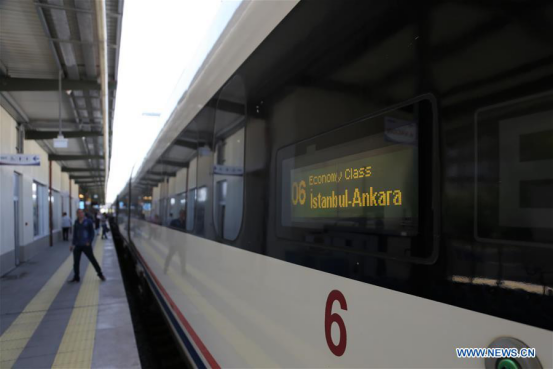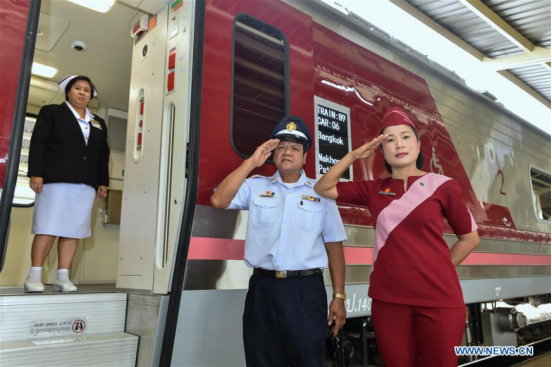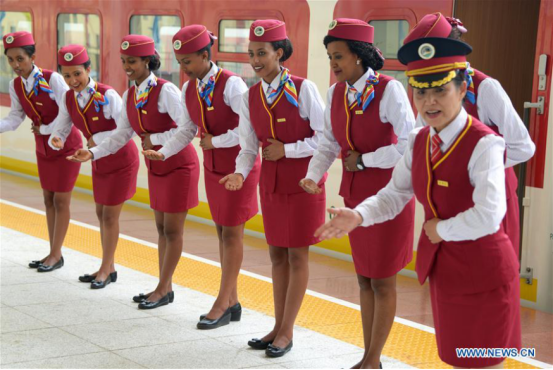China's high-speed railway: the best 'souvenir' foreigners wish to bring home
China has built one of the world's most extensive high-speed rail networks in just a few years. What's more, it has even been able to offer quality rail products and supplies to other countries. What follows are just a few of China's recent cooperation projects overseas.
Ankara-Istanbul High-Speed Train
As the first high-speed rail that went into operation in Turkey, Ankara-Istanbul high-speed rail links the Turkish capital with the country's most populous city of Istanbul.
China Railway Construction Corporation and China National Machinery Import and Export Corporation, in partnership with two Turkish companies, built a 158-km-long line of the project in between the Inonu-Vezirhan and Vezirhan-Kosekoy sections.
Photo taken on April 30, 2017 shows a train of Istanbul-Ankara high-speed railway in Pendik Station, Istanbul, Turkey. The second phrase of the principal project of Ankara-Istanbul high-speed railway, built jointly by Chinese-Turkish consortium, was completed in July 2014. [Photo/Xinhua] |
Moscow-Kazan Railway
In June 2017, Chinese and Russian companies signed a contract on jointly conducting pre-construction survey and design of the Moscow-Kazan high-speed railway in Russia. The deal was inked between the Russian Railways and a consortium consisting of China Railway Eryuan Engineering Group (CREEC) and two Russian companies.
The 770-km railway is a key infrastructure development project in Russia, which will span the frozen lands between Moscow and Kazan, capital of the Tatarstan Republic. In the long run, it will become part of the planned Beijing-Moscow high-speed transport corridor.
The photo taken on April 26, 2017 shows the main body of a railway bridge connecting China and Russia. [Photo/Xinhua] |
Jakarta-Bandung High-Speed Railway (HSR)
The Jakarta-Bandung HSR project contract was signed in Jakarta in early April 2017 between consortium joined by Chinese and Indonesian firms and KCIC, a China-Indonesia joint firm tasked with monitoring the project.
The 142-km-long railway project is the first of such in Indonesia as well as in the whole region of Southeast Asia. It would shorten the traveling time between the two cities from three hours to 40 minutes and spur economic activities along the line.
Photo taken on July 15, 2017 shows the the construction site of the Walini tunnel project of the High-Speed Railway (HSR) linking Indonesian capital Jakarta to Bandung. The Walini tunnel project of the High-Speed Railway (HSR) linking Indonesian capital Jakarta to Bandung was launched here Saturday. [Photo/Xinhua] |
Sino-Thai Railway
Thailand and China have been negotiating to thrash out details on jointly building a medium-speed railway line in 2015. The railway project, once completed, will connect northeast Thailand's Nong Khai province, capital Bangkok and eastern Rayong province. It is also expected to join the planned China-Laos railway.
In 2016, State Railway of Thailand (SRT) has contracted China Railway Rolling Stock Corporation (CRRC) Changchun Railway Vehicles Co., LTD to purchase 115 new carriages at a price of 4.98 billion Baht (143 million U.S. dollars). The first new train was launched in August 2016 with a short trip in Thailand.
Train attendants wait at the entrance of the Chinese-made new train at Hua Lamphong station in Bangkok, Thailand, Aug. 29, 2016. A new train purchased from China by State Railway of Thailand (SRT) was launched on Monday with a short trip, which is the first new train for Thailand in 20 years. [Photo/Xinhua] |
China-Laos Railway
The China-Laos railway has a total length of 414.332 kilometers with over 62.7 percent of bridges and tunnels, linking Mohan-Boten border gate in northern Laos and capital Vientiane. It is the first overseas route connecting with the railway system in China, using Chinese technology, equipment and investment.
Construction of the project is scheduled for five years with investment of some 40 billion Chinese yuan (5.8 billion U.S. dollars), 70 percent of which comes from Chinese investment and the rest 30 percent from Lao side. The operating speed on the route is designed at 160 km per hour.
Photo taken on May 21, 2017 shows a tunnel of China-Laos railway under construction in northern Laos' Luang Prabang Province. [Photo/Xinhua] |
Kenya's Mombasa-Nairobi Standard Gauge Railway (SGR)
The 480-km SGR stretches from the port of Mombasa to Kenya's capital Nairobi, involving a total investment of 3.8 billion U.S. dollars, which makes it Kenya's largest infrastructure project since its independence.
Construction of the railway began in December 2014 with China Road and Bridge Corporation (CRBC) being the contractor. In May 2017, Kenya began operations on the Chinese-built SGR in a drive to revolutionize its transportation sector and speed up industrialization.
A train runs on Kenya's Mombasa-Nairobi Railway on May 29, 2017. The 480 km railway linking Kenya's largest port city Mombasa to capital Nairobi, slated to be officially launched on May 31, will be a key infrastructure project that will push forward the East Africa nation's modernization drive, a senior company executive said Monday. [Photo/Xinhua] |
Ethiopia-Djibouti Railway
The 752.7-km Ethiopia-Djibouti railway, also known as Addis Ababa-Djibouti railway, was constructed by China Railway Group and China Civil Engineering Construction Corporation with a total investment of 4 billion U.S. Dollars. It is Africa's first modern electrified railway with a designed speed of 120 km per hour.
The railway is the first built using complete sets of Chinese equipment and standards outside China. It is also the second trans-national railway built by Chinese in Africa, following the Tazara railway, which was built in the 1970s linking Tanzania's Dar es Salaam with Zambia's Kapiri Mposhi.
|
Chinese conductor Ding Jihua (R) trains the Ethiopian attendants at a railway station in suburban Addis Ababa, Ethiopia, Oct. 1, 2016. A Chinese-built railway linking the Ethiopian capital and the port of Djibouti is expected to help the landlocked African country improve access to the sea and speed up a burgeoning industrialization process. [Photo/Xinhua] |






